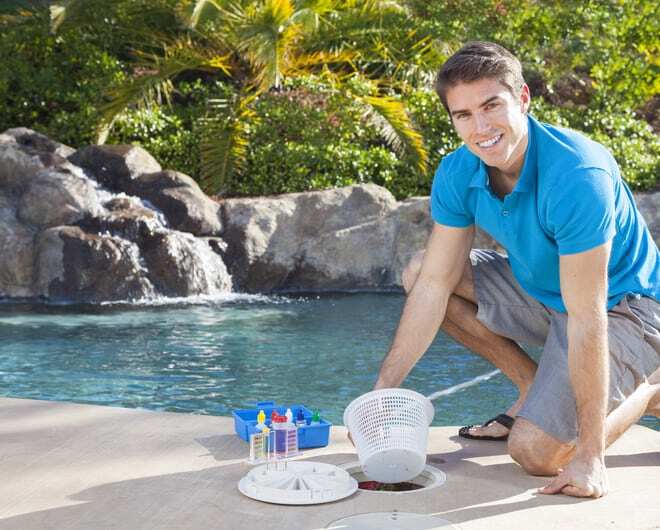
Now that school’s out for summer, it’s time to get your pool ready for lots of swimming. An ideal swimming pool not only looks clean but the water is properly circulated and sanitized. A well circulated and sanitized pool is a safe pool to swim in. Surfaces are free of debris and leaves, the water is a clear blue color, and your pump isn’t so loud it’s annoying your neighbors.
A beautifully cared for pool is the most appealing thing on a hot summer day. When you look at all the equipment it takes to run your pool, how do you know which parts to pay attention to?
Let’s look at the main pool equipment that you shouldn’t ignore when it comes to service and repairs:
- Pump
- Heater
- Filter
These three pieces of equipment are most often know to be the costliest, but if you’re smart about the type of equipment you choose and how often you service it, you could end up saving your money and your sanity in the long run.
Pump
When we’re in the pool, our bodies absorb some of the water through the skin. Naturally, you wouldn’t want any harmful bacteria in the water to be absorbed by anyone swimming in the pool. Protecting your loved ones from bacteria and other water impurities is what pool pumps do best. Typical pool pumps run for about eight hours every day but the most efficient, energy saving pumps can run up to 16 hours a day so it’s important they’re running properly. Yes, that’s right, the latest pumps and equipment set ups can be set to run twice as long and save more money than running a typical pump with basic equipment at 6 to 8 hours a day.
Did you know that if you take an early morning swim and then head back into the water later that afternoon, you’re not swimming in the exact same water? When the pool pump is running, it turns over the water and runs it through a circulation system. This creates a water flow that pushes dirt and debris through the water to the filter and helps circulate chemicals so the water can get properly cleaned. The result is algae- and bacteria-free water to swim in. The longer the equipment can circulate and filter the water, the cleaner and safer it will be.
There are more intricate steps along the way, but this basic overview explains why a pool pump is essential to a healthy pool. If you have an older pool pump, it may be working overtime and it may even be costing you. Replacing a pump with an energy-efficient product is a great way to have peace of mind that your pool is running properly without overspending. Additional benefits include:
- Use 30 to 60 percent less energy than the standard pool pump
- Variable-speed motor lets the water run slower so filter elements last longer
- Less wear and tear on moving parts
- Quieter motor operation when on low speeds
- Longer-lasting equipment because it doesn’t have to work as hard
Filter
The filter does the heavy lifting. It’s part of the circulation system mentioned above and is credited with clearing out dirt, debris, bacteria, and anything else that shouldn’t be in the pool water. The pump and the filter work hand in hand and should both be able to handle the same capacity of water flow. The pump pulls the water in, the filter cleans it.
When people picture a pool filter, they often think of a small piece of material that inserts into a pipe opening. When you look at your pool’s equipment, the filter is usually the largest item. The filter is away from the pool and provides a physical barrier against small and large contaminants before the water is pushed back into the pool or to the heater. Regularly cleaning your filter will ensure that your pump doesn’t have to work too hard to move the water through your water features or cleaning system. A really dirty filter can bring your water flow to a virtual crawl where your water feature is down to only a trickle or cause your cleaning system to hardly work.
Clean pool water makes the other equipment work better and help it last longer, so it’s important to make sure yours is working properly.
Heater
For pools or spas with a heater, this is the next step in the circulation system after the filter. The pump pushes the water to the filter, and then once it’s clean, it gets pushed to the heater. Depending on the type of heater—natural gas or propane—it generates heat that is transferred to the water before it makes its way back to the pool or spa.
Neglecting a pool heater is not a good idea, even if you’re not using it. Because of the complicated parts and safety issues, it’s recommended that you hire a professional to regularly service your heater or check it annually to ensure the longevity of the equipment and year round enjoyment of your family.
For more information on pool equipment or to schedule a service, call us at 602-532-3887 or fill out our contact form online. For more information about why you should choose Shasta Pools for your service or repair, check out our website.
Dhruv Gangwal is the Marketing Director at Shasta Pools, Arizona’s leading pool builder. With extensive experience in strategic marketing, consumer behavior, and the evolving trends of outdoor living, Dhruv is dedicated to helping homeowners make informed, confident decisions about their pool investments. He works closely with Shasta’s design and sales teams to craft educational resources that simplify the pool-buying process and highlight the latest innovations in backyard living. Dhruv’s articles provide practical advice that homeowners can trust.
Topics:

